GL End User Transaction Download
The Transaction Download is available on the UAB GL End User menus. It provides the "detail" version of the Account Statement transactions in an Excel format.
UAB GL END USER→REPORTS→UAB TRANSACTION DOWNLOAD
The UAB TRANSACTION DOWNLOAD was created in response to users' need to get detail financial transaction information in an excel format. It is available to all users with UAB GL END USER responsibility. Very similar in design to the Monthly Account Statement Transaction (MAST) report, parameters are entered the same way. Resulting reports are subject to the parameters defined by the user at the time of submission. Results are returned in the Concurrent Manager, and can be exported into excel.
The data for this report should be automatically subsetted to what the inquiring user can access per their Oracle access responsibilities. Data can further be subsetted using the following parameters:
- Deliver-To Person
- Dollar Type
- Account String(s)
- Organizational Unit(s)
- GL JE Categories
- GL JE Sources
- Object Code(s)
To create the UAB TRANSACTION DOWNLOAD for GL Account Strings:
1. From the BEGIN PERIOD field, trigger the LOV list and select the beginning period for which data is needed.
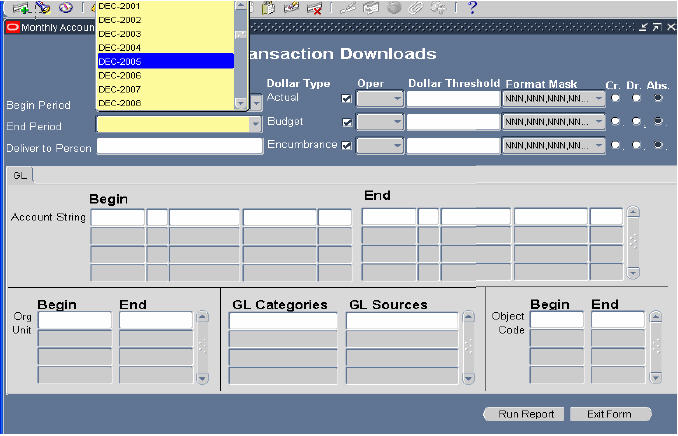
2. From the END PERIOD field, trigger the LOV list and select the last month for which data is needed. 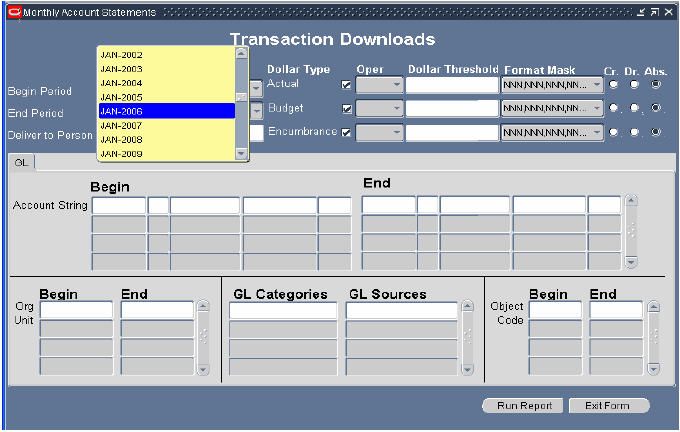
It is possible to limit the report data to GL account strings for which the Deliver-To Person attribute is a specific individual.
3. To narrow search results by Deliver-To person, click in the DELIVER TO PERSON field to trigger the LOV list and select the person from the list.
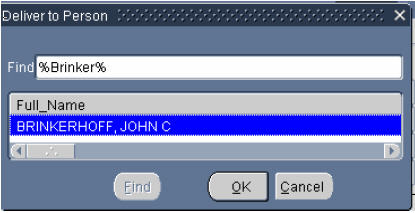
Note: This field is not required to be used; if nothing is selected in this field, the system will return all account strings that meet the selected criteria, regardless of who the Deliver-To Person for that string might be. This Deliver-To Person subset is used in combination with any other subset criteria (i.e. Dollar Type, Project String, Org Unit, Category, Source, or Object Code) specified on the parameter form for this report run.
4. Select the dollar type of the transactions desired in the results by clicking in the check box beside the appropriate transaction type to select/deselect it.
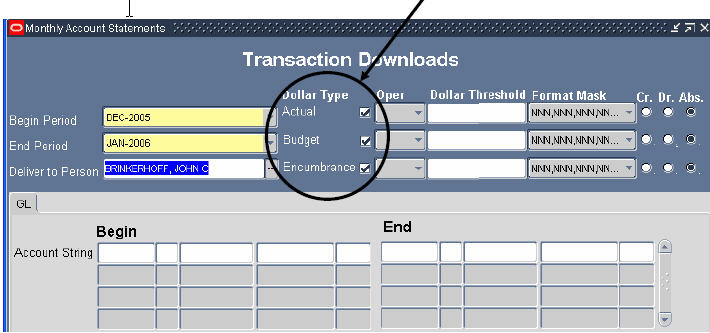
Note: If the DOLLAR TYPE ABE parameters are not changed, the resulting Transaction Download will automatically include Actual, Budget, & Encumbrance dollar transactions. This is usually preferred.
5. Enter any OPERATOR/DOLLAR THRESHOLD parameters, if applicable.
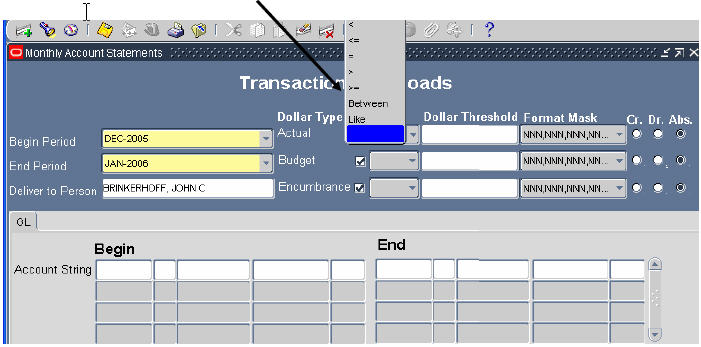
Note: If the OPERATOR/DOLLAR THRESHOLD parameters are not entered, the resulting Transaction Download will automatically include all of the selected transactions regardless of dollar amount. This is normally preferred However, to only review transactions equal to a specified dollar amount, greater than a specified dollar amount, equal to or greater than a specified dollar amount, or less than a specified dollar amount, the OPERATOR/DOLLAR THRESHOLD amounts must be specified for each ABE dollar type included in the report. The OPERATOR is selected from a LOV. The DOLLAR THRESHOLD is directly keyed (with pennies indicated by a decimal and two digits following the decimal; do NOT type in any commas).
6. Enter any CR/DR/ABS parameters, if applicable.
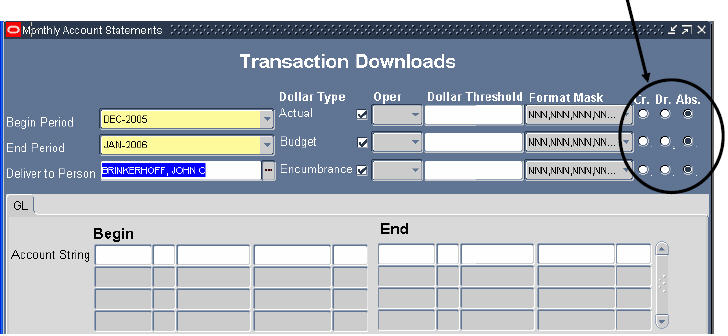
Note: If the ABS/CR/DR parameters are not changed, the default of ABS (which is the abbreviation for "absolute") will mean that the resulting Transaction Download will automatically include all transactions specified in the ABE & OPER/THRESHHOLD columns of this section. This is normally preferred. However, using these parameters can limit the selected dollar amounts to instead look at only credits or only debits by clicking on the applicable radial buttons in this section of the form.
Entering the Account String
The download data can be limited to a particular GL account string segment value(s). In the BEGIN section there are five columns, one column for each of the account string segment values (i.e. the ASBOF). Similarly, there are five columns in the END section.
There is no LOV for these values. An understanding of the GL account string structure is needed to assist in selecting ranges of segment values. To specify a specific account string, the full account string must be known, or its alias can be used. For assistance with understanding the GL account string structure, click here.
7. In the ACCOUNT STRING area, enter the needed account information for the desired results.
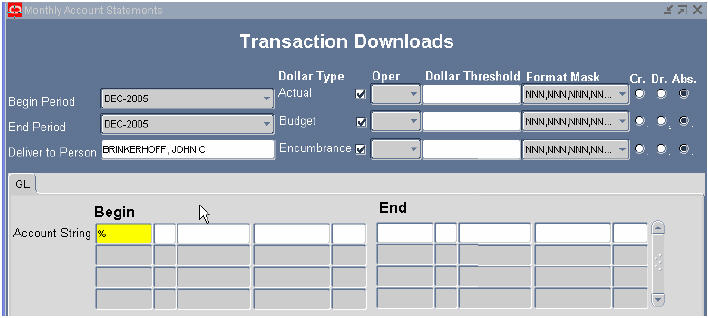
Note: Even if you do not want to further subset your search criteria by account string segment values, you must at least put a wild card "%" in the first account segment field of the ACCOUNT STRING section.
WARNING: A user can run the report for everything they have access to by simply putting a percent sign in the first ACCOUNT STRING field. However, if a user has access to a large volume of account strings, it could take a long time for the report to run and the resulting report could be quite large. So, it may be preferable to use several of the transaction subset criteria to limit the scope of the inquiry.
There are several ways in which to enter account segment information and narrow the report results.
Scenario 1: Searching by a Single Account String(s)
When entering search criteria for a single account string, only the BEGIN column(s) of the desired segment are required to be entered. While the same account string segment(s) can also be entered as the END column search criteria, use of the END columns is required only when searching for a range of accounts. To search multiple account strings without searching within a range, simply enter the necessary account segments for each account on a separate row.
To search for a single account string, users can enter the full account string or enter a single segment of the account string. Note: Searching by the BAL or ORG segment alone may yield results for multiple accounts, as those segment values can be shared by multiple accounts. Using the ACCT segment is the only segment guaranteed to yield only one result
Below are examples of the various ways the ACCOUNT STRING fields can be entered.
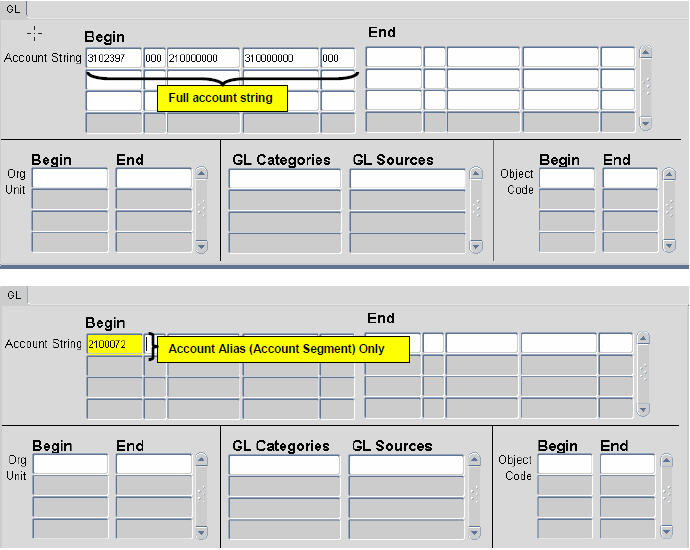
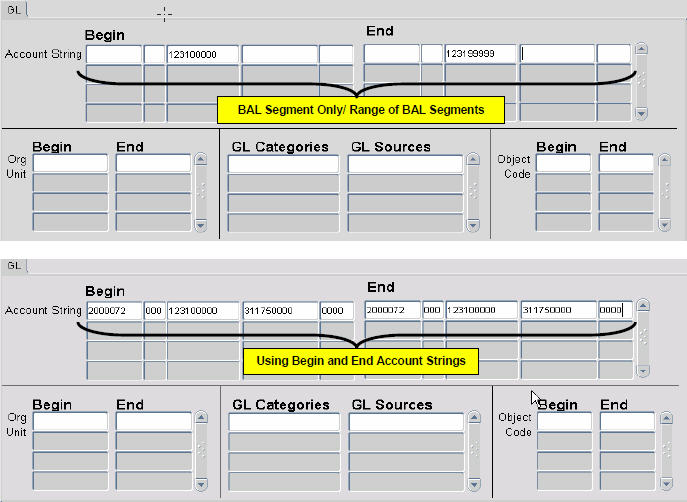
Scenario 2: Searching for a Range of Accounts
Oftentimes, transactions may need to be downloaded for a range of accounts. Instead of entering each individual account string, users may enter a range of account strings. The download will return all accounts within that range that meet all of the search criteria.
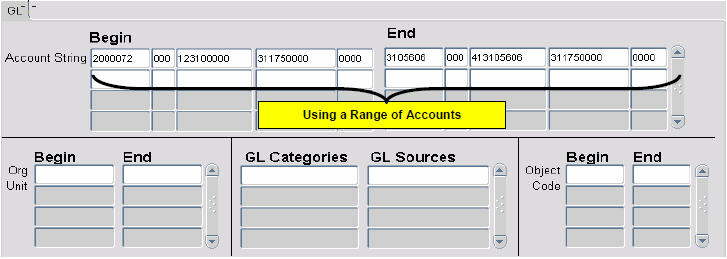
Note: Remember, GL account access is restricted based on user responsibility, so only the accounts within the range for which the user has access will be displayed in the results.
Scenario 3: Searching by ORG Number
For GL account strings, to only specify ORG segment values, it is possible to use the ORG block of this form, instead of the account string section of this form. As with the ACCOUNT STRING fields, users can search for a single Org, multiple Orgs (by using separate lines), or a range of Orgs. Also like the ACCOUNT STRING fields, the ending ORG field is only required if searching within a range of Orgs.
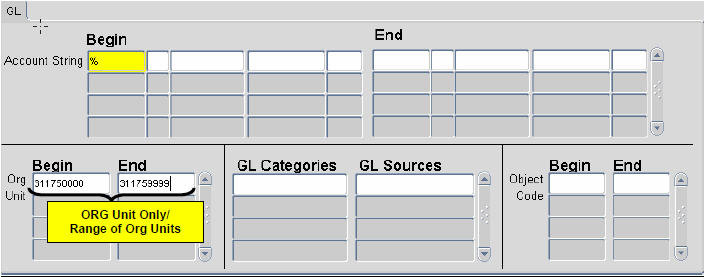
Note: Remember, GL account access is restricted based on user responsibility, so only the Org units within the range for which the user has access will be displayed in the results.
Also, even if you do not want to further subset your search criteria by account string segment values, you must at least put a wild card "%" in the first account segment field of the ACCOUNT STRING section.
Scenario 4: Searching by GL Categories
Report data can be limited to transactions with particular JE Header Category value(s) by clicking into the GL CATEGORIES field and selecting the applicable Category from the resulting LOV. This field is not required; if left blank, the system will return all account strings that meet the other search criteria regardless of what the JE Category for that transaction is.
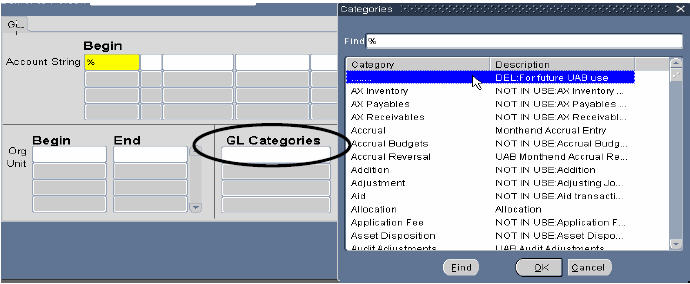
Scenario 5: Searching by GL Sources
Report data can be limited to transactions with particular JE Header Source value(s) by clicking into the GL SOURCES field and selecting the applicable Source from the resulting LOV. This field is not required; if left blank, the system will return all account strings that meet the other search criteria regardless of what the JE Header Source for that transaction is.
Note: Remember, GL account access is restricted based on user responsibility, so only the Org units within the range for which the user has access will be displayed in the results.
Also, even if you do not want to further subset your search criteria by account string segment values, you must at least put a wild card "%" in the first account segment field of the ACCOUNT STRING section.
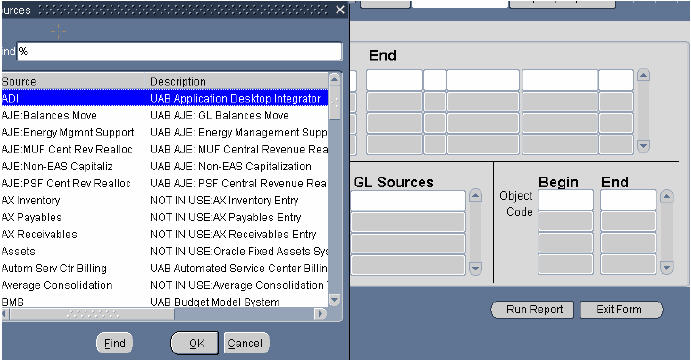
Scenario 6: Searching by Object Code
Report data can be limited to transactions with particular object code(s) by entering the object code(s) or range of object codes into the OBJECT CODE field. There is no LOV for these fields, so the object code must be known. Click here to access UAB's Official Object Code Listing.
This field is not required; if left blank, the system will return all account strings that meet the other search criteria regardless of what the object code for that transaction is. As with the ACCOUNT STRING fields, users can search for a single object code, object codes (using separate lines), or a range of object codes. Also like the ACCOUNT STRING fields, the ending END OBJECT CODE field is only required if searching within a range of object codes.
Note: Remember, GL account access is restricted based on user responsibility, so only the Org units within the range for which the user has access will be displayed in the results.
Also, even if you do not want to further subset your search criteria by account string segment values, you must at least put a wild card "%" in the first account segment field of the ACCOUNT STRING section.
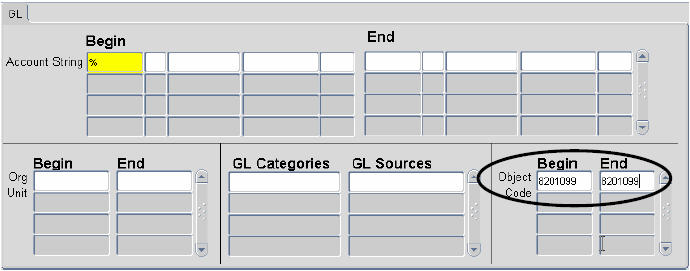 8. Once all needed search criteria has been entered, click on the RUN REPORT button.
8. Once all needed search criteria has been entered, click on the RUN REPORT button.
 9. A small pop-up box will appear. Record the REQUEST VALUE. Then, click OK.
9. A small pop-up box will appear. Record the REQUEST VALUE. Then, click OK.
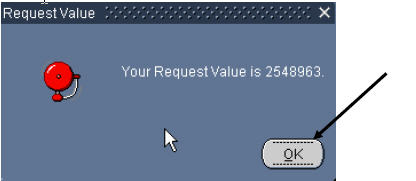
Clicking the OK button will clear the parameter screen. At this point it is possible to define more criteria for a new report, or to look for the output report(s) already run.
10. To find your report results, click View and then click Requests from the main Toolbar.
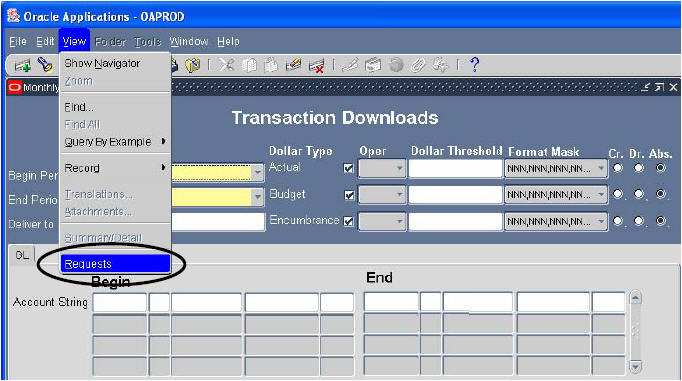
The FIND REQUESTS window will appear. From this window, users can find requests by completion status or specific requests using the Request ID. The default find setting is All My Requests.
11. Change or enter information as needed. Then, click the FIND button on the FIND REQUESTS window to view selected requests.
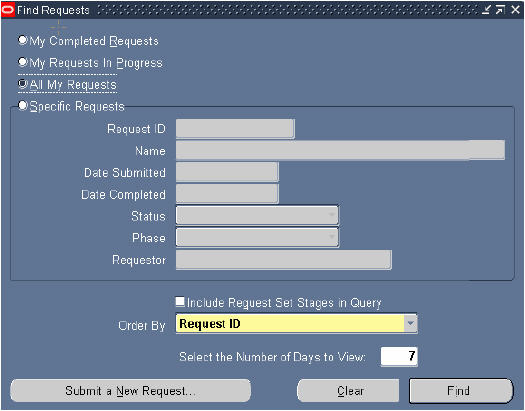 12. Find the desired report in the list of returned report requests. After the request is completed, click on VIEW OUTPUT button.
12. Find the desired report in the list of returned report requests. After the request is completed, click on VIEW OUTPUT button.
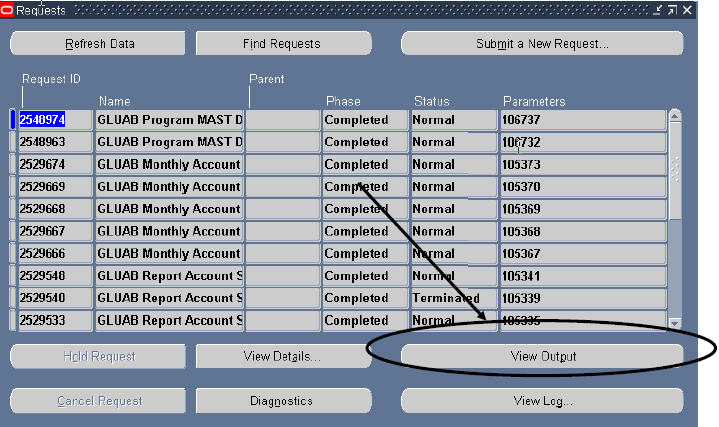
Note: The PHASE field identifies at which point of the process the report is in currently. Valid phases are Pending, Running, and Completed. Click on the REFRESH DATA button in the top, left-hand area of the window to see the update of the Phase. The STATUS field maintains the status of the report request. The only valid statuses are Standby, Normal, and Error. The final field is the PARAMETERS field and lists the subsetted parameters applied to this report request before submission.
15. A VIEWER OPTION window will open. Select Excel from the available options, then click OK.
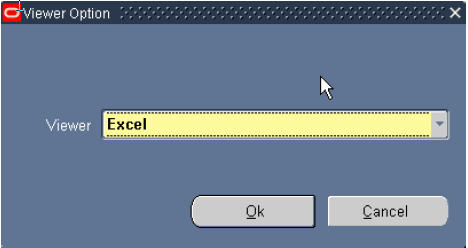 16. Next a FILE DOWNLOAD window will open. Click OPEN to go directly to the report, or click SAVE to save the report in a location on the computer.
16. Next a FILE DOWNLOAD window will open. Click OPEN to go directly to the report, or click SAVE to save the report in a location on the computer.
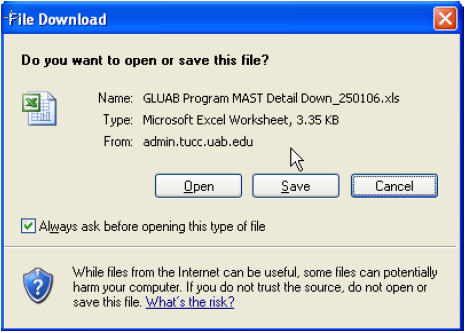 If you select OPEN, and you are running Office 2007 or later, you will get the following message:
If you select OPEN, and you are running Office 2007 or later, you will get the following message:

Click YES.
17.To save to the computer, select a location, rename if desired, and click the SAVE button.
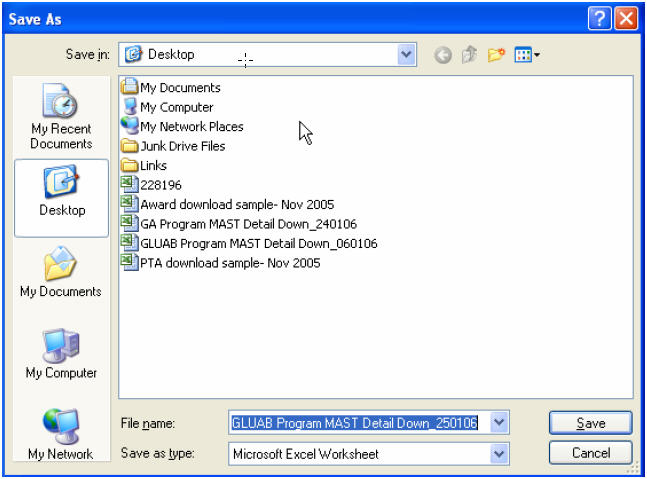
18. Go to the save location to open the file.
The resulting report will resemble the following:

Unlike the Account Statements, this download can be sorted/edited as needed.